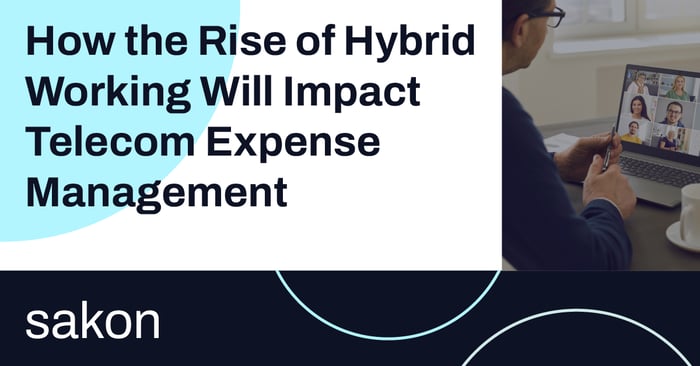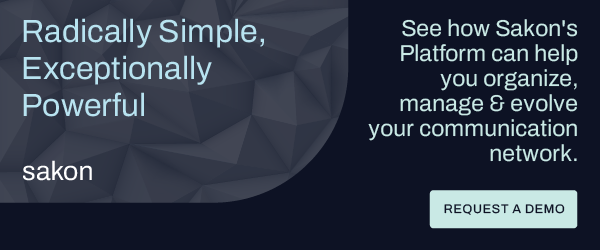Let’s look back briefly to a world pre-pandemic. Back then, wireless, wired, and other telecom services accounted for approximately 30% of a company’s technology budget.
Having everyone in the same building working on company-issued devices made it easy to manage and secure company information and maintain a reliable network infrastructure.
The COVID-19 pandemic changed all of that.
Most organizations have had to accommodate work-from-home arrangements for their employees. This has made it more difficult for them to effectively carry out their telecom management responsibilities and ensure end-users are able to work efficiently and securely on their own devices. Seeing as enterprises will likely be reeling from the long-term effects of the global pandemic for the foreseeable future, TEM providers now have to evolve their service offerings.
Let’s take a closer look at how the rise of hybrid work environments is impacting telecom expense management as a whole.

Telecom Expenses Are Starting to Pile Up
Organizations that have to support remote employees are now struggling to get a grip on their telecom expenses, from implementing a well-running cloud infrastructure to reimbursing employees for internet services, mobile data usage, laptops, and more.
With no signs of remote work environments fading into the rearview anytime soon, enterprises need to make telecom expense management a top priority for their business. With the right TEM strategies in place, your enterprise can improve productivity, ease demands on your internal teams, and dedicate more time to focus on innovation and driving revenue.
According to a recent study by Global Industry Analysts Inc, the global market for telecom expense management is expected to reach a revised size of $5.2 Billion by 2026, growing at a CAGR of 10.4% between now and then.
This growth shows that enterprises are increasingly needing to optimize and streamline their telecom costs wherever possible in order to efficiently serve their end-users and support their devices.
TEM Needs Are Becoming Increasingly Complex
Mobile device management is an important part of any TEM provider’s tech stack, but enterprises expect more in today’s day and age. Companies aren’t just using more data on a daily basis, but the complexity of their data is also becoming increasingly sophisticated.
While baseline TEM solutions may have been sufficient for enterprises a few years ago, organizations now expect TEM providers to offer adjacent services that enable them to effectively manage their complex data and its associated costs. These adjacent services could include inventory tracking of cloud-based services, IoT expense management, MACD services, and Unified Communications as a Service.
As companies have worked to accommodate their remote workforces, leaders are increasingly relying on TEM experts to provide guidance on how to best manage their network, end-users, and their devices. For this reason, TEM providers need to evolve their service offerings to include capabilities outside of just network-related solutions. They should act as trusted advisors instead of third-party outsiders.
The Bar is Being Raised for TEM Providers
Companies that have never called on a TEM provider may not bat an eye at average service quality and baseline network solutions. They’ll likely be thrilled to have experienced professionals handling their tedious TEM responsibilities. But for enterprises that have more sophisticated TEM needs, the bar has been raised for TEM providers to provide exceptional service that delivers tangible results.
In Gartner’s Market Guide for Telecom Expense Management Services, research indicated that enterprises expect TEM providers to manage their logistics, in addition to taking on life cycle management services for end-user devices. They are also expecting more proactivity from TEM providers in streamlining their estate across technology towers in order to eliminate duplicity.
On top of that, enterprises want to ensure that what they’re paying for is actually paying off. Service level agreements (SLAs) between companies and TEM providers now typically include details around providing regular performance analytics and in-depth, itemized invoices. In short, TEM providers need to be able to walk the walk if they want to truly impress their customers.
Ongoing, robust TEM services are the new norm in today’s world. Hybrid workforces are going to continue expecting instant, easy, and flexible access to tools that make remote working and real-time collaboration seamless, and without being limited to working on a single device. In order for TEM providers to keep up with industry standards, they’ll need to up their game and deliver world-class service and support that addresses the full scope of their clients’ telecom management needs.
In the World of TEM, Opportunities Await
Many TEM providers may feel threatened by the emergence of hybrid workforces. After all, telecom expense management was brought on by enterprises relying on old legacy networks and physical network infrastructures to power their employees. Now that times have changed, and enterprises are opting for cloud-based solutions that simplify and streamline their network architecture, where do TEM providers fit into the future?
In reality, the future looks bright for those that have embraced the evolution of telecom management and adjusted their service offerings to meet today’s challenges. Enterprises are being pressured to start controlling their budgets and services associated with managing communications and network infrastructure, and many of them don’t know where to begin. That’s where a quality TEM provider can be an enterprise’s best friend.
Sakon believes in the importance of TEM for an increasingly Hybrid Working environment. To see how our platform could work within your enterprise, schedule a free demo today!
